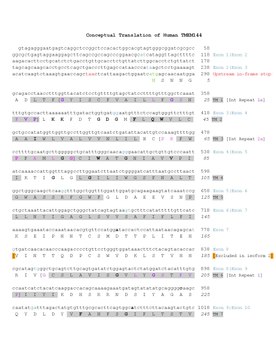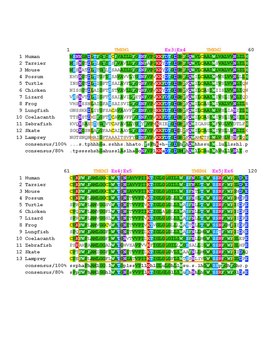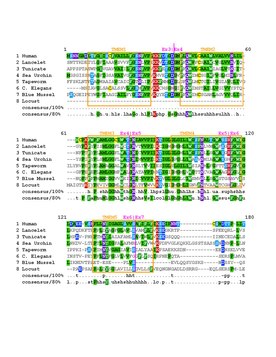
Transmembrane Protein 144 (TMEM144) is a protein in humans encoded by the TMEM144 gene.
Gene
Transmembrane Protein 144 is located on the plus strand of chromosome 4 (4q32.1), spanning a total of 40,857 base pairs. The TMEM144 gene transcribes a mRNA sequence 3,210 nucleotides in length and composed of 13 exons.
Protein
There exist two isoforms of human Transmembrane Protein 144. Isoform one consist of 345 amino acids with a total mass of 37.6 kDa. This isoform has a theoretical isoelectric point of 6.63. The second isoform is 169 amino acids long with a mass of 18.3 kDa.

Expression
TMEM144 is over-expressed in adult brain tissue with low regional specificity. TMEM144 appears enriched in oligodendrocytes and immune cells, such as dendritic cells and monocytes.
Cellular Localization
Precise cell localization has multiple predicted locations. Localization tools state TMEM144 is likely found in the plasma membrane, endoplasmic reticulum, Lysosome/Vacuole, or Golgi apparatus. However, an immunofluorescent staining of various human cell lines display localization to the mitochondria.
Post Translational Modifications
There exists five predicted post translational modifications for TMEM144, including four sites of phosphorylation and a sumoylation site.

Interacting Proteins
Several proteins have been observed to be physically associated with TMEM144, including Transmembrane Protein 237, Homocysteine-Responsive Endoplasmic Reticulum-Resident Ubiquitin-Like Domain Member 2 Protein, Translocase of Inner Mitochondrial Membrane Domain-Containing Protein 1, Free Fatty Acid Receptor 2, Aquaporin 6, Serine Rich Single-Pass Membrane Protein 1, and Adrenoceptor Beta 2.
Homology
Transmembrane Protein 144 arose approximately 694 million years ago in desert locust. It can be found in both vertebrates and invertebrates. It takes TMEM144 approximately 6.8 million years to make a 1% change to its amino acid sequence, indicating a moderately low rate of evolution.


Ortholog Table
| Genus and Species | Common Name | Taxonomic Class | Median Date of Divergence (MYA) | Accession # | Sequence Length (aa) | Sequence Identity (%) | Sequence Similarity (%) |
|---|---|---|---|---|---|---|---|
| Homo Sapiens | Human | Mammalia | 0 | NP_060812.2 | 345 | 100.0 | 100.0 |
| Carlito syrichta | Philippine tarsier | Mammalia | 69 | XP_012639059.1 | 345 | 94.2 | 97.4 |
| Mus musculus | House mouse | Mammalia | 87 | NP_001366471.1 | 348 | 85.9 | 92.2 |
| Trichosurus vulpecula | Brushtail possum | Mammalia | 160 | XP_036620586.1 | 349 | 77.7 | 90.3 |
| Chelydra serpentina | Snapping turtle | Reptilia | 319 | KAG6931534.1 | 358 | 67.0 | 84.1 |
| Gallus gallus | Red junglefowl | Aves | 319 | XP_420383.2 | 357 | 66.9 | 82.6 |
| Zootoca vivipara | Viviparous lizard | Reptilia | 319 | XP_034969125.1 | 360 | 65.9 | 82.3 |
| Rana temporaria | Common frog | Amphibia | 353 | XP_040188243.1 | 358 | 64.2 | 81.0 |
| Protopterus annectens | West African lungfish | Dipnoi | 408 | XP_043918387.1 | 407 | 56.4 | 69.6 |
| Latimeria chalumnae | African coelacanth | Coelacanthi | 414 | XP_014346971.1 | 407 | 56.0 | 71.6 |
| Danio rerio | Zebrafish | Actinopterygii | 431 | NP_001005983.1 | 380 | 50.0 | 64.8 |
| Amblyraja radiata | Thorny skate | Chondrichthyes | 464 | XP_032874310.1 | 486 | 45.7 | 58.4 |
| Branchiostoma lanceolatum | European lancelet | Leptocardii | 556 | CAH1267272.1 | 402 | 44.1 | 58.8 |
| Petromyzon marinus | Sea lamprey | Hyperoartia | 599 | XP_032811478.1 | 396 | 50.1 | 64.9 |
| Ciona intestinalis | Vase tunicate | Ascidiacea | 603 | XP_026696612.1 | 395 | 46.6 | 59.2 |
| Strongylocentrotus purpuratus | Purple sea urchin | Echinoidea | 619 | XP_030836295.1 | 363 | 46.8 | 64.7 |
| Echinococcus multilocularis | Cyclophyllid tapeworm | Cestoda | 694 | CDS37915.1 | 351 | 41.0 | 59.8 |
| Caenorhabditis elegans | Roundworm | Chromadorea | 694 | NP_498062.2 | 345 | 38.7 | 56.0 |
| Mytilus edulis | Blue mussel | Bivalvia | 694 | CAG2251154.1 | 385 | 36.0 | 52.0 |
| Schistocerca gregaria | Desert locust | Insecta | 694 | XP_049849104.1 | 278 | 25.6 | 44.1 |
Clinical Significance
Transmembrane Protein 144 is predicted to be a direct or indirect negative regulator of kisspeptin. High expression of TMEM144 is prognostically favorable for patient with endometrial cancer. Whereas in patients with pancreatic cancer, high expression of TMEM144 is associated with poor prognostic outcomes.
References
- ^ NCBI Gene (National Center for Biotechnology Information Gene Database) entry on TMEM144 <https://www.ncbi.nlm.nih.gov/gene/55314>.
- NCBI Nucleotide (National Center for Biotechnology Information Nucleotide Database) entry on TMEM144 <https://www.ncbi.nlm.nih.gov/nuccore/NM_018342.5>.
- ^ UniProt entry of TMEM144 <https://www.uniprot.org/uniprotkb/Q7Z5S9/entry#sequences>.
- NCBI Protein (National Center for Biotechnology Information Protein Database) entry on TMEM144 <https://www.ncbi.nlm.nih.gov/protein/NP_060812.2>.
- ExPASy Compute pI/Mw tool entry on TMEM144 protein <https://web.expasy.org/compute_pi/>.
- Sjöstedt, Evelina; Zhong, Wen; Fagerberg, Linn; Karlsson, Max; Mitsios, Nicholas; Adori, Csaba; Oksvold, Per; Edfors, Fredrik; Limiszewska, Agnieszka; Hikmet, Feria; Huang, Jinrong; Du, Yutao; Lin, Lin; Dong, Zhanying; Yang, Ling; Liu, Xin; Jiang, Hui; Xu, Xun; Wang, Jian; Yang, Huanming; Bolund, Lars; Mardinoglu, Adil; Zhang, Cheng; von Feilitzen, Kalle; Lindskog, Cecilia; Pontén, Fredrik; Luo, Yonglun; Hökfelt, Tomas; Uhlén, Mathias; Mulder, Jan (6 March 2020). "An atlas of the protein-coding genes in the human, pig, and mouse brain". Science. 367 (6482). doi:10.1126/science.aay5947. PMID 32139519. S2CID 212560645.
- ^ TMEM144 entry on the Human Protein Atlas <https://www.proteinatlas.org/ENSG00000164124-TMEM144>.
- Karlsson, Max; Zhang, Cheng; Méar, Loren; Zhong, Wen; Digre, Andreas; Katona, Borbala; Sjöstedt, Evelina; Butler, Lynn; Odeberg, Jacob; Dusart, Philip; Edfors, Fredrik; Oksvold, Per; von Feilitzen, Kalle; Zwahlen, Martin; Arif, Muhammad; Altay, Ozlem; Li, Xiangyu; Ozcan, Mehmet; Mardinoglu, Adil; Fagerberg, Linn; Mulder, Jan; Luo, Yonglun; Ponten, Fredrik; Uhlén, Mathias; Lindskog, Cecilia (30 July 2021). "A single–cell type transcriptomics map of human tissues". Science Advances. 7 (31). Bibcode:2021SciA....7.2169K. doi:10.1126/sciadv.abh2169. PMC 8318366. PMID 34321199.
- Monaco, Gianni; Lee, Bernett; Xu, Weili; Mustafah, Seri; Hwang, You Yi; Carré, Christophe; Burdin, Nicolas; Visan, Lucian; Ceccarelli, Michele; Poidinger, Michael; Zippelius, Alfred; Pedro de Magalhães, João; Larbi, Anis (February 2019). "RNA-Seq Signatures Normalized by mRNA Abundance Allow Absolute Deconvolution of Human Immune Cell Types". Cell Reports. 26 (6): 1627–1640.e7. doi:10.1016/j.celrep.2019.01.041. PMC 6367568. PMID 30726743.
- PSORT II entry on human TMEM144 protein <https://psort.hgc.jp/cgi-bin/runpsort.pl>.
- DeepLoc entry of human TMEM144 protein for cell localization prediction <https://services.healthtech.dtu.dk/service.php?DeepLoc-2.0>.
- NetPhos 3.1 entry on human TMEM144 <https://services.healthtech.dtu.dk/service.php?NetPhos-3.1>.
- GPS SUMO entry on human TMEM144 <http://sumosp.biocuckoo.org/showResult.php Archived 2018-05-06 at the Wayback Machine>.
- Luck, Katja; Kim, Dae-Kyum; Lambourne, Luke; Spirohn, Kerstin; Begg, Bridget E.; Bian, Wenting; Brignall, Ruth; Cafarelli, Tiziana; Campos-Laborie, Francisco J.; Charloteaux, Benoit; Choi, Dongsic; Coté, Atina G.; Daley, Meaghan; Deimling, Steven; Desbuleux, Alice; Dricot, Amélie; Gebbia, Marinella; Hardy, Madeleine F.; Kishore, Nishka; Knapp, Jennifer J.; Kovács, István A.; Lemmens, Irma; Mee, Miles W.; Mellor, Joseph C.; Pollis, Carl; Pons, Carles; Richardson, Aaron D.; Schlabach, Sadie; Teeking, Bridget; Yadav, Anupama; Babor, Mariana; Balcha, Dawit; Basha, Omer; Bowman-Colin, Christian; Chin, Suet-Feung; Choi, Soon Gang; Colabella, Claudia; Coppin, Georges; D'Amata, Cassandra; De Ridder, David; De Rouck, Steffi; Duran-Frigola, Miquel; Ennajdaoui, Hanane; Goebels, Florian; Goehring, Liana; Gopal, Anjali; Haddad, Ghazal; Hatchi, Elodie; Helmy, Mohamed; Jacob, Yves; Kassa, Yoseph; Landini, Serena; Li, Roujia; van Lieshout, Natascha; MacWilliams, Andrew; Markey, Dylan; Paulson, Joseph N.; Rangarajan, Sudharshan; Rasla, John; Rayhan, Ashyad; Rolland, Thomas; San-Miguel, Adriana; Shen, Yun; Sheykhkarimli, Dayag; Sheynkman, Gloria M.; Simonovsky, Eyal; Taşan, Murat; Tejeda, Alexander; Tropepe, Vincent; Twizere, Jean-Claude; Wang, Yang; Weatheritt, Robert J.; Weile, Jochen; Xia, Yu; Yang, Xinping; Yeger-Lotem, Esti; Zhong, Quan; Aloy, Patrick; Bader, Gary D.; De Las Rivas, Javier; Gaudet, Suzanne; Hao, Tong; Rak, Janusz; Tavernier, Jan; Hill, David E.; Vidal, Marc; Roth, Frederick P.; Calderwood, Michael A. (16 April 2020). "A reference map of the human binary protein interactome". Nature. 580 (7803): 402–408. Bibcode:2020Natur.580..402L. doi:10.1038/s41586-020-2188-x. PMC 7169983. PMID 32296183.
- TMEM144 entry on IntAct <https://www.ebi.ac.uk/intact/search?query=tmem144>
- ^ NCBI BLAST Protein entry on Homo sapiens TMEM144 (NP_060812.2) to identify various orthologs <https://blast.ncbi.nlm.nih.gov/Blast.cgi?PAGE=Proteins>.
- TimeTree of Life entry of Homo sapiens compared to ortholog species in Table 1 <http://www.timetree.org/>.
- Prentice, Leah M; d'Anglemont de Tassigny, Xavier; McKinney, Steven; Ruiz de Algara, Teresa; Yap, Damian; Turashvili, Gulisa; Poon, Steven; Sutcliffe, Margaret; Allard, Pat; Burleigh, Angela; Fee, John; Huntsman, David G; Colledge, William H; Aparicio, Samuel AJ (December 2011). "The testosterone-dependent and independent transcriptional networks in the hypothalamus of Gpr54 and Kiss1 knockout male mice are not fully equivalent". BMC Genomics. 12 (1): 209. doi:10.1186/1471-2164-12-209. PMC 3111392. PMID 21527035.
- ^ Uhlen, Mathias; Zhang, Cheng; Lee, Sunjae; Sjöstedt, Evelina; Fagerberg, Linn; Bidkhori, Gholamreza; Benfeitas, Rui; Arif, Muhammad; Liu, Zhengtao; Edfors, Fredrik; Sanli, Kemal; von Feilitzen, Kalle; Oksvold, Per; Lundberg, Emma; Hober, Sophia; Nilsson, Peter; Mattsson, Johanna; Schwenk, Jochen M.; Brunnström, Hans; Glimelius, Bengt; Sjöblom, Tobias; Edqvist, Per-Henrik; Djureinovic, Dijana; Micke, Patrick; Lindskog, Cecilia; Mardinoglu, Adil; Ponten, Fredrik (18 August 2017). "A pathology atlas of the human cancer transcriptome". Science. 357 (6352). doi:10.1126/science.aan2507. PMID 28818916.